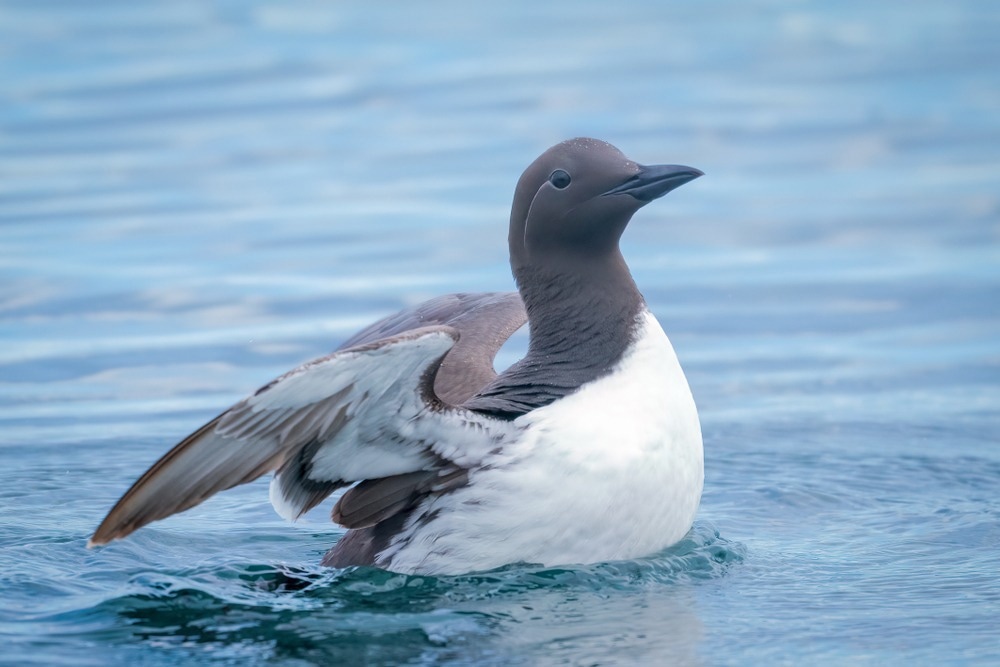An investigation of microplastic contamination in Monterey Bay discovered the widespread presence of microplastics in seawater and the digestive tracts of common murres, and the anchovies these diving seabirds prey on.

Image Credit: Linda Burek/Shutterstock.com
Researchers assessing the prevalence and composition of microplastics in Monterey Bay found microparticles in the digestive tracts of 58% of the anchovies (above) and 100% of the common murres (below) they examined.
The research, published in Environmental Pollution, involved analyzing microplastic particles retrieved from murres for estrogenic activity, indicating the possibility of hormone disruption. The scientists found that all the murres studied had microparticles in their digestive tracts, with nearly a quarter (23%) having estrogenic activity.
These tiny plastic particles are leaching substances that have the potential for hormonal disruption that can have cascading effects on reproductive and immune functions.
Myra Finkelstein, Study Senior Author and Adjunct Professor, Environmental Toxicology, University of California, Santa Cruz
The research, headed by UC Santa Cruz graduate student Sami Michishita, aimed to assess the abundance and composition of microparticles in Monterey Bay. Researchers discovered microparticles (particles smaller than 5 mm) in the digestive tracts of 58% of anchovies and 100% of murres.
Using an optical technique known as Raman spectroscopy, the majority of the particles (78%) were recognized as fibers, and more than half of the particles (57%) were recognized as plastic.
Raman spectroscopy was performed in partnership with Jenessa Gjeltema at the University of California, Davis School of Veterinary Medicine, and estrogenic activity testing was performed in collaboration with the San Diego Zoo Wildlife Alliance.
When you’re looking at tiny fibers under the microscope, you can’t always tell if it’s cotton or polyester, so we took that next step to determine what it was, and then took the further step of testing them for estrogenic activity.
Myra Finkelstein, Study Senior Author and Adjunct Professor, Environmental Toxicology, University of California, Santa Cruz
Seawater samples collected from two intake systems in Santa Cruz and Moss Landing had around 2 microparticles per 1,000 liters. Since anchovies feed by sifting tiny plankton from seawater, the particles would most likely collect in their digestive systems. Anchovies, as a significant portion of the murres’ diets, are most likely a primary source of microplastics in the murres’ digestive tracts.
Finkelstein has spent years researching the effects of plastic pollution on seabirds. Many seabirds mistake big particles of plastic (macroplastics) for food and consume them.
One of the main problems with macroplastics is that they’re taking the place of food. With microplastics, a major concern is the toxic compounds that may be leaching out of it.
Myra Finkelstein, Study Senior Author and Adjunct Professor, Environmental Toxicology, University of California, Santa Cruz
Several of the chemicals included in plastics are regarded as endocrine disrupting compounds since they can imitate hormones like estrogen in the body by attaching to hormone receptors and altering physiological functioning.
The investigators did not attempt to determine how the microplastics would influence murres or anchovies in this investigation. That is a more tough topic to investigate, and one that Finkelstein’s team is currently attempting to answer in partnership with the San Diego Zoo Wildlife Alliance.
Finkelstein adds, “The next step is to see how this may be affecting the birds. With microplastics, it seems we are finding them anywhere we look. But we need to do more work to find out what the biological impact is.”
“We know plastic debris, both large and small, in our oceans and waterways is an issue. This partnership between UCSC and San Diego Zoo Wildlife Alliance gives us the chance to dig into the reproductive consequences for seabirds when they consume microplastics. We believe this is the first time this type of estrogen-based assessment is being conducted for this type of widespread marine pollution,” stated Christopher Tubbs, associate director of reproductive sciences at San Diego Zoo Wildlife Alliance.
In addition to Michishita, Finkelstein, and Tubbs, the study’s coauthors include Corinne Gibble at the California Department of Fish and Wildlife; Rachel Felton at the San Diego Zoo Wildlife Alliance; and Jenessa Gjeltema and Jackelyn Lang at UC Davis School of Veterinary Medicine.
The research was supported by the Friends of the Seymour Center, UC Santa Cruz, and the NorCal Society of Environmental Toxicology and Chemistry.
Journal Reference:
Michishita, S., et al. (2022) Microplastic in northern anchovies (Engraulis mordax) and common murres (Uria aalge) from the Monterey Bay, California USA - Insights into prevalence, composition, and estrogenic activity. Environmental Pollution. doi.org/10.1016/j.envpol.2022.120548.